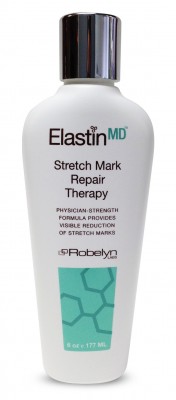What is a stretch mark?
A stretch mark is a generic term given to a dermatological condition known as striae (singular stria). Essentially its scarring of the skin caused by tearing of the dermis. Causes include weight loss or weight gain, pregnancy, weight lifting, and puberty. Basically any situation that causes rapid or repeated stress on the skin (sometimes in conjunction with hormonal changes) can cause damage to the skin and result in stretch marks.
Stretch marks can appear anywhere on the body but are generally found on the abdomen and hips (especially when related to pregnancy), breasts, thighs, and arms. The appearance of stretch marks can vary in severity. They range from slightly off-color, white scars to deep purple, reddish marks. Severe stretch marks may naturally fade over time but can persist as dark scars.
Pregnancy and stretch marks
During pregnancy, a womens body under goes many changes that combine to increase the likely hood of stretch marks. The body prepares itself by increasing glucocorticoid hormones that enable the skin and uterus to stretch more than would be typically possible. Maternity induced stretch marks typically appear in the third trimester as the uterus and abdomen and weight gain and fluid retention are at their maximum. Postnatal stretch marks can form on the breasts as the milk supply increases in preparation and during breastfeeding. And of course, as pregnancy weight is lost, changes in the skin can also form stretch marks.
An ounce of prevention can help avoid stretch marks
Genetics affects stretch mark formation, since some folks have naturally more elastic skin, but good nutrition, and application of stretch mark prevention creams has also been demonstrated effective. Studies have shown that application of stretch mark prevention and treatment creams can help to mitigate or prevent the formation of stretch marks. Various ingredients and emollients have been studied including vitamin E, hyaluronic acid, elastin and collagen, shea butter, and of course cocoa butter.
Stretch mark removal or reduction
There are several expensive medical treatments available for severe stretch marks including dermal abrasion, prescriptive retinoid creams, and laser resurfacing. In addition, surgical procedures such as tummy-tucks can be beneficial in reducing or masking the appearance of stretch marks. Though resurfacing and surgery to treat stretch marks are elective procedures and therefore not typically covered under insurance. So its not an option for everyone.
Alternatives to medical treatments
Studies have shown that topical treatments can improve or remove the appearance of stretch marks. Again, various ingredients have been researched and shown to improve the appearance of stretch marks. And while results vary based on severity and genetics in most cases daily application of stretch mark repair or prevention creams helped to reduce stretch marks. Optimally, its best to utilize a prevention cream to minimize the risk of stretch mark formation - especially during pregnancy. Existing stretch marks can be treated with stretch mark prevention formulas to some effect, but for best results, a stretch mark removal cream is best. The ingredients required to minimize or eliminate existing stretch marks in removal treatments are more aggressive and therefore not always appropriate for sensitive patients - especially during pregnancy.
So if you have stretch marks or want to prevent their formation - make sure you find the best stretch mark cream for you and keep using it until youve seen the improvements you desire or youre no longer at risk for developing stretch marks. Topical treatment options to treat and reduce the appearance of stretch marks do exist and the results can be amazing.
May 04, 2012
By: laney














There are 0 comments for this entry. Leave a comment below »
Leave a comment. *Required